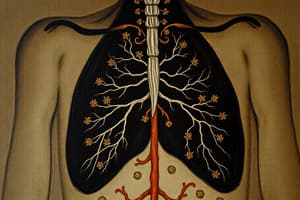Podcast
Questions and Answers
According to the provided table of leading causes of death in the US for 2007, which of the following lifestyle factors contributes to the highest number of listed causes?
According to the provided table of leading causes of death in the US for 2007, which of the following lifestyle factors contributes to the highest number of listed causes?
- Poor diet
- Inactive lifestyle (correct)
- Excessive alcohol use
- Smoking
Which of the following is the MOST accurate definition of diabetes based on the information provided?
Which of the following is the MOST accurate definition of diabetes based on the information provided?
- A condition where the body excessively produces insulin, leading to hypoglycemia.
- A condition exclusively caused by poor dietary choices and lack of exercise.
- A metabolic disease characterized by hyperglycemia due to defects in insulin secretion, insulin action, or both. (correct)
- A rare genetic disorder affecting insulin production from birth.
In a normal person, what is the role of the pancreas in glucose regulation?
In a normal person, what is the role of the pancreas in glucose regulation?
- Pancreas is involved in carbohydrate digestion in the intestine
- The pancreas stores glucose for later use by the body.
- The pancreas produces glucagon to increase blood glucose levels.
- The pancreas produces insulin to facilitate glucose uptake by cells. (correct)
What is the primary difference between Type I and Type II diabetes?
What is the primary difference between Type I and Type II diabetes?
Which of the following mechanisms explains how insulin facilitates glucose uptake by cells?
Which of the following mechanisms explains how insulin facilitates glucose uptake by cells?
What is the primary long-term effect of insulin resistance on insulin secretion?
What is the primary long-term effect of insulin resistance on insulin secretion?
According to the information about physical activity and glucose uptake, what is a hypothesized mechanism by which exercise increases glucose uptake?
According to the information about physical activity and glucose uptake, what is a hypothesized mechanism by which exercise increases glucose uptake?
According to the graph depicting glucose uptake during exercise in diabetics, at an exercise intensity of 200 Watts, approximately how much glucose is taken up after 40 minutes?
According to the graph depicting glucose uptake during exercise in diabetics, at an exercise intensity of 200 Watts, approximately how much glucose is taken up after 40 minutes?
Which of the following is identified as a critical objective in treating diabetes?
Which of the following is identified as a critical objective in treating diabetes?
What was the primary focus of the UK diabetes study mentioned in the slides?
What was the primary focus of the UK diabetes study mentioned in the slides?
According to the UK diabetes study, what approach seemed to control blood glucose levels more effectively?
According to the UK diabetes study, what approach seemed to control blood glucose levels more effectively?
What strategy is suggested to prevent weight gain, particularly in the context of diabetes management?
What strategy is suggested to prevent weight gain, particularly in the context of diabetes management?
Which of the following was a key inclusion criteria for participants in the Finnish Diabetes Prevention Study?
Which of the following was a key inclusion criteria for participants in the Finnish Diabetes Prevention Study?
What was one of the five major goals for the intervention group in the Finnish Diabetes Prevention Study?
What was one of the five major goals for the intervention group in the Finnish Diabetes Prevention Study?
What was the primary outcome measure used to assess the effectiveness of the interventions in the Finnish Diabetes Prevention Study?
What was the primary outcome measure used to assess the effectiveness of the interventions in the Finnish Diabetes Prevention Study?
Which key finding emerged from the Finnish Diabetes Prevention Study regarding the impact of exercise?
Which key finding emerged from the Finnish Diabetes Prevention Study regarding the impact of exercise?
In comparing the UK study and the Finnish study, what general conclusion can be drawn regarding diabetes intervention strategies?
In comparing the UK study and the Finnish study, what general conclusion can be drawn regarding diabetes intervention strategies?
What was the primary goal related to weight loss for the lifestyle modification group in the Diabetes Prevention Program (DPP) study?
What was the primary goal related to weight loss for the lifestyle modification group in the Diabetes Prevention Program (DPP) study?
What was the recommended amount of moderate-intensity physical activity for the lifestyle modification group in the DPP study?
What was the recommended amount of moderate-intensity physical activity for the lifestyle modification group in the DPP study?
According to the slide summarizing interventions, how do medication, diet, and lifestyle modifications compare in terms of their effects on weight?
According to the slide summarizing interventions, how do medication, diet, and lifestyle modifications compare in terms of their effects on weight?
Which of the following main symptoms of diabetes is MORE common in Type 1 than Type 2 diabetes?
Which of the following main symptoms of diabetes is MORE common in Type 1 than Type 2 diabetes?
What are the hormones released by the pancreas and what is its role in normal individuals?
What are the hormones released by the pancreas and what is its role in normal individuals?
In the Finnish Diabetes Prevention Study, which is true about the intervention group?
In the Finnish Diabetes Prevention Study, which is true about the intervention group?
Why is type II diabetes is mostly present during obesity?
Why is type II diabetes is mostly present during obesity?
Besides Diabetes, which of the following diseases is covered in the content?
Besides Diabetes, which of the following diseases is covered in the content?
One of the interventions discussed was, 'Lifestyle modifications vs. Medication: DPP study', what does DPP stand for?
One of the interventions discussed was, 'Lifestyle modifications vs. Medication: DPP study', what does DPP stand for?
A patient is diagnosed with diabetes after a fasting blood sugar test reveals a glucose level of 130 mg/dL. According to the criteria outlined in the slides, what does this result indicate?
A patient is diagnosed with diabetes after a fasting blood sugar test reveals a glucose level of 130 mg/dL. According to the criteria outlined in the slides, what does this result indicate?
Which of the following statements best characterizes insulin resistance?
Which of the following statements best characterizes insulin resistance?
According to the information presented, which chronic disease is NOT listed among the leading causes of death in the United States in 2007?
According to the information presented, which chronic disease is NOT listed among the leading causes of death in the United States in 2007?
In the context of the UK Diabetes Study, what specific medications were examined for their effect on diabetes management?
In the context of the UK Diabetes Study, what specific medications were examined for their effect on diabetes management?
Based on the Finnish Diabetes Prevention Study, which of the following combinations of interventions is most effective in preventing development of diabetes in pre-diabetic individuals?
Based on the Finnish Diabetes Prevention Study, which of the following combinations of interventions is most effective in preventing development of diabetes in pre-diabetic individuals?
How do the independent effects of medication, lifestyle modification and diet lead to the best diabetes outcome?
How do the independent effects of medication, lifestyle modification and diet lead to the best diabetes outcome?
Assuming that a patient is suffering from diabetes as well as kidney disease and hypertension, according to the information provided, what lifestyle factors would MOST benefit the patient?
Assuming that a patient is suffering from diabetes as well as kidney disease and hypertension, according to the information provided, what lifestyle factors would MOST benefit the patient?
What is a potential downside associated with relying solely on diet for diabetes management, as indicated in the slides?
What is a potential downside associated with relying solely on diet for diabetes management, as indicated in the slides?
Which of the following statements accurately connects a component of diabetes physiology with a potential intervention strategy?
Which of the following statements accurately connects a component of diabetes physiology with a potential intervention strategy?
You're advising a patient newly diagnosed with Type 2 diabetes. They express concern about the complexity of managing their condition. Based on the information presented, what single piece of advice could you give them that addresses multiple facets of diabetes management?
You're advising a patient newly diagnosed with Type 2 diabetes. They express concern about the complexity of managing their condition. Based on the information presented, what single piece of advice could you give them that addresses multiple facets of diabetes management?
According to the content, what is the most difficult thing to do?
According to the content, what is the most difficult thing to do?
Flashcards
What is diabetes?
What is diabetes?
Metabolic disease characterized by high glucose concentration in the blood.
What is Hyperglycemia?
What is Hyperglycemia?
High glucose concentration in the blood, fasting blood sugar is more than 100 mg/dl.
Type I Diabetes
Type I Diabetes
Rare, typically appears at birth.
Type II Diabetes:
Type II Diabetes:
Signup and view all the flashcards
Insulin Secretion Trigger
Insulin Secretion Trigger
Signup and view all the flashcards
What do Glut transporters do?
What do Glut transporters do?
Signup and view all the flashcards
Insulin Resistance
Insulin Resistance
Signup and view all the flashcards
Exercise and Glucose Uptake
Exercise and Glucose Uptake
Signup and view all the flashcards
Critical objective for treating diabetes
Critical objective for treating diabetes
Signup and view all the flashcards
How to prevent weight gain
How to prevent weight gain
Signup and view all the flashcards
Finnish Diabetes Prevention Study
Finnish Diabetes Prevention Study
Signup and view all the flashcards
Intervention goals for diabetes prevention
Intervention goals for diabetes prevention
Signup and view all the flashcards
Diabetes Prevention Program (USA)
Diabetes Prevention Program (USA)
Signup and view all the flashcards
Weight loss goal
Weight loss goal
Signup and view all the flashcards
Impact of exercise
Impact of exercise
Signup and view all the flashcards
Independent effects of Lifestyle modification
Independent effects of Lifestyle modification
Signup and view all the flashcards
Study Notes
- Physical activity has a number of benefits to selected chronic diseases.
- Discussed chronic diseases include diabetes, osteoporosis, and obesity.
Diabetes Physiology
- For a normal person, carbohydrate digestion and absorption in the intestine releases glucose in the blood.
- The pancreas releases insulin.
- Glucose uptake occurs in the liver, muscle, and adipose tissue.
What is Diabetes?
- Diabetes is a metabolic disease characterized by hyperglycemia.
- Hyperglycemia is a high glucose concentration in the blood.
- Fasting blood sugar more than 100 mg/dl indicates hyperglycemia.
- More than 126 mg/dl blood indicates diabetes.
- Insulin assists in glucose uptake.
- Insulin is a naturally occurring hormone produced by the pancreas.
- Diabetes is due to defects of insulin.
- Defects can be from insulin deficiency, resistance to insulin, or both.
Types of Diabetes
- Type I diabetes is rare and present from birth.
- Type II diabetes accounts for 90 to 95% of diabetic cases.
- Type II typically presents as an adult onset, but can be found in children.
- Type II is commonly present due to obesity.
Diabetes Symptoms
- Common symptoms of diabetes include excessive thirst (polydipsia).
- Another symptom is increased hunger (polyphagia).
- Other symptoms include lethargy and stupor, blurred vision, and acetone breath.
- Additional symptoms are weight loss and Kussmaul breathing (hyperventilation).
- Some experience nausea, vomiting, and abdominal pain.
- Frequent urination (polyuria) and glucose in the urine (glycosuria) are other symptoms.
Diabetic Trend
- Diabetes cases are trending upwards.
Glucose Uptake via Insulin Action
- Insulin is a protein.
- Glucose must have insulin to move from blood into a cell.
- Increased blood glucose causes the pancreas to secrete insulin.
- Insulin binds to a signaling receptor on a cell membrane and activates a pathway.
- This stimulates 'Glut transporters' inside the cell, which bind to the cell surface.
- Vesicles open for glucose entry into the cell.
- Glucose is then stored as glycogen
Insulin Resistance
- Insulin resistance means less glucose uptake for a given insulin concentration.
- A long-term effect of insulin resistance is increased insulin secretion.
- Another effect of insulin resistance is β-cell death.
- Obesity is a major contributor to insulin resistance, specifically intra-abdominal fat.
Physical Activity/Exercise and Glucose Uptake
- There is limited knowledge on this subject.
- Exercise provides an insulin-independent uptake mechanism.
- Exercise stimulates ‘Glut transporters’ for glucose uptake.
- A hypothesized mechanism is calcium-mediated uptake.
- Dynamic exercise can increase glucose uptake 50-fold.
Exercise and Diabetics
- Leg glucose uptake increases over time during exercise as measured in mmol/min.
- 200 Watts shows the greatest increase, followed by 130 Watts, and then 65 Watts.
Treating Diabetes
- One critical objective is to reduce overweight/obesity.
- Ideal treatment options include diet, medications, and lifestyle modifications.
Interventions
- A UK diabetes study focused on diet only vs. diet and medication.
- A Finland study focused on the effect of lifestyle modification.
- A DPP study focused on lifestyle modifications vs. medication.
UK Diabetes Study: Diet vs Medication
- The UK diabetes study examined the effect of weight loss through diet on diabetes.
- It also studied the effect of diabetes medications (Metformin, Exogenous Insulin).
- 5012 diabetics were put on a diet in the first 3 months resulting in a 5 kg weight loss.
- After 3 months, half continued diet therapy only.
- The other half continued diet and medication therapy.
- Adding medications was found to control blood glucose better.
- Incorporating an active lifestyle with diet can prevent weight gain.
Finnish Diabetes Prevention Study
- The Finnish Diabetes Prevention Study focused on combining diet and exercise.
- It included 522 pre-diabetics.
- The participants had fasting glucose between 100 and 125 mg/dl, and were insulin resistant.
- Participants were 40-65 years old and overweight (BMI>25 kg/m²).
- The study included a 3-year follow-up.
- There was a control group that received oral explanations once a year.
- Benefits were explained such as good diet, weight reduction, and regular physical activity.
- The intervention group followed the ‘whole nine yards’ approach.
- The intervention group had 5 major goals.
- These included 5% body weight loss.
- Other included less than 30% of total caloric intake from fat, less than 10% from saturated fat.
- Further goals included increased fiber intake.
- Finally, moderate exercise for at least 30 mins/day and more than 4 hrs/week.
- The primary outcome measure was the incidence of diabetes.
- The intervention group had a big decrease in diabetes incidence.
- Exercising had an independent effect in decreasing diabetes, even in the absence of weight loss.
- Lifestyle modification was found to be ‘super effective'.
- Medication works better than just dietary modification.
- Lifestyle modification works wonders.
USA Diabetes Prevention Program
- A USA diabetes prevention program was conducted
- It measured the incidence of diabetes using three groups of 3200 prediabetics.
- The three groups included control, medication, and lifestyle modification.
- The control group received a placebo and standard recommendations.
- They received written information and one meeting explaining benefits of a healthy lifestyle.
- The medication group received Metformin and standard recommendations.
- Metformin works to increase uptake of glucose into the liver from blood.
- The lifestyle modification group followed the "whole nine yards".
- The lifestyle modification group had a goal to maintain a 7% weight loss from baseline weight.
- They followed a low-calorie and low-fat diet.
- The exercise followed was moderate intensity activity for at least 150 min/week.
- There was a 4-year follow up.
- Independent lifestyle modification effects include weight loss and preventing weight gain.
- Medication effects include minimal weight loss even with an exercise effect, though it does have side effects.
- Diet only resulted in regaining weight rapidly, exercise effects were absent, and there was an earlier need for medications.
- Different modes can be adopted to increase physical activity.
Studying That Suits You
Use AI to generate personalized quizzes and flashcards to suit your learning preferences.




